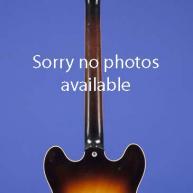A Wonderful "Black Guard" Telecaster
This fifty-two-year-old Butterscotch Blond beauty weighs just 7.50 lbs. and has a nut width of 1 5/8 inches and a scale length of 25 1/2 inches. Solid ash body and fretted maple neck with 21 frets and black dot position markers. Single round string tree. Headstock decal with "Fender" spaghetti logo in silver with black trim and "Telecaster" in black below it. Individual "no-name" Kluson Deluxe tuners with oval metal buttons. The tuning keys are stamped "235677/PAT. APPLD." on the bottom base. One plain metal-cover "black-bottom" pickup with slot-head adjusting screws (at neck) with an output of 5.37k, and one black six-polepiece "copper-coated metal plate bottom" pickup with flush polepieces (angled in bridgeplate) with an output of 5.42k. Single-ply black bakelite pickguard with five screws. Two controls (one volume, one tone) plus three-way "tone" switch (with slot-head screws) and original Daka Ware black plastic "barrel-like" tip, all on metal plate adjoining pickguard. Shorter chrome knobs with more pronounced domes and heavy knurled sides. Telecaster combined bridge/tailpiece with three (flat-ground on bottom) brass saddles. Serial number ("3969") on the bridge plate beneath the words "FENDER/PAT. PEND." The neck is dated in pencil "TG. 3-30-53" (Tadeo Gomez). The body neck-pocket is dated in red pencil "10-53 Babe." The name in the neck cavity is probably [Virgilio] Babe [Simoni] (a long-time Fender employee). The control cavity has "Gloria 11/2/53" in pencil on a piece of masking tape, indicating the day the pickups and wiring harness were installed into the body and the name of the woman who did it (see A.R. Duchossoir, The Fender Telecaster, p. 74). The potentiometers are stamped "304 333" (Stackpole August 1953), the three-way switch is stamped "CRL 1452," the capacitor between the switch and the volume control is stamped "IMFD 150 VDC," and the capacitor between the pots is stamped "ZSW 1S5 [?]."
This guitar is in excellent plus (8.75) condition. There is considerable good old-fashioned playing wear on the maple fretboard and the guitar has been expertly refretted with slightly larger gauge frets. There is one small ding (measuring approximately 5/8 x 1/8 inch) on the top of the guitar, a tiny bit of belt buckle scarring on the back, and a small amount of playing wear, mainly on the edges, where the guitar has rubbed against the player's body. The Butterscotch Blond has mellowed to a rich, creamy color. The lovely grain of the ash body shows very well through the finish, and this fifty-two-year-old gem is quite simply one of the best "black guard" Telecasters that we have ever seen! Housed in a mid to late fifties Fender "tweed" hardshell case with light brown plush lining (8.00). Complete with its original "ashtray" bridge cover.
"Leo Fender's new solidbody was the instrument that we know now as the Fender Telecaster, effectively the world's first commercially successful solidbody electric guitar...The guitar was originally named the Fender Esquire and then the Fender Broadcaster, and it first went into production in 1950. It was a simple, effective instrument. It had a basic, single-cutaway, solid slab of ash for a body, with a screwed-on maple neck. Everything was geared to easy production. It had a slanted pickup mounted into a steel bridge-plate carrying three adjustable bridge-saddles, and the body was finished in a yellowish color known as blond. It was unadorned and like nothing else. It was ahead of its time (Tony Bacon, 50 Years of Fender, p. 10).
"Both the Telecaster and the Esquire kept their basic 1951 appointments until the mid-50s. In retrospect, their most striking features -- at least cosmetically speaking -- are a typical yellowed blonde finish (a.k.a. 'butterscotch' finish) and a black pickguard, hence the often cited notion of early 'black guard' Tellies. The combination of the two actually gives a distinct look to the early 50s models, which are otherwise considered by many as the ultimate classic Telecaster guitar because of their tone...Besides its peculiar hue, the original blonde finish nicely showcases the ash body heavy grain pattern that later whiter finishes would subdue...[1954] marks the beginning of a number of changes in the appointments of Telecaster guitars. By Fall, the bakelite black guard was replaced by a single ply white trim and a few months later steel superseded brass for the bridge saddles. FENDER also changed the finishing process of the blonde finish...The typical 'butterscotch' colour gave way to a creamier shade which would soon evolve into a lighter off-white finish. Finally, 1954 is also the year when the serial number was removed from the bridge plate to be stamped on the neck anchor plate...Beyond these cosmetic features, a more dramatic evolution took place in 1955. The bridge pickup was modified to incorporate staggered pole pieces in place of the flush level-poles of the original design...Finally, the round clubby neck of the post-1950 guitars evolved into pronounced 'V' feel by 1955 and until early 1958 'boat necks' were the rule on most Fender instruments...At the end of 1956, Telecaster guitars no longer looked or even sounded exactly the same as the 1951 models...In the course of 1958, necks gradually changed for a flatter cross section" (A.R. Duchossoir, The Fender Telecaster, p. 16).
"The earliest necks made in 1950 (e.g. Broadcaster) have a pronounced V-shape and their thickness is usually close to one inch. If one takes the 1st and 12th fret as a reference for the cross-section, .95" and 1.00" would be a good average indication for the period. By early 1951, necks became more rounded and less 'Veed' with slight variations in thickness, e.g. .90" and 1.00" on a '52 Telly, but overall kept a similar cross-section until the mid-50's." (A.R. Duchossoir, The Fender Telecaster, p. 53).
Translate:


